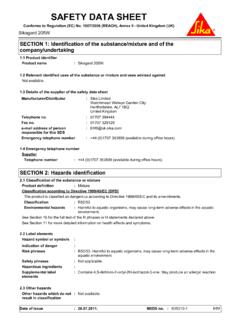Transcription of SAFETY DATA SHEET Hydrochloric Acid 32 - 36%
1 SAFETY data SHEETH ydrochloric acid 32 - 36% SECTION 1: Identification of the substance/mixture and of the company /undertakingDate Product identifierProduct nameHydrochloric acid 32 - 36%SynonymsSaltsyre 32 - 36%REACH Reg No01-2119484862-27EC Relevant identified uses of the substance or mixture and uses advised againstUse of the substance/preparationpH regulation. Production of PVC. Acidity substance in Details of the supplier of the SAFETY data sheetDistributor company nameAcinor ASOffice addressTitangt. 13, NO-1630 Gamle FredrikstadPostal addressTitangaten 13 Postcode1630 CityGamle 984 648 324 MVAC ontact personRolf Egil de Emergency telephone numberEmergency telephoneToxic Information:22 59 13 00 SECTION 2: Hazards Classification of the substance or mixtureClassification according to 67/548/EEC or 1999/45/ECXi; R37C; R34 Classification according to Regulation (EC) No 1272/2008 [CLP/GHS]Skin Corr 1B; H314;STOT SE3; H335;Substance / mixture hazardous propertiesCauses severe skin burns and eye damage.
2 Irritating to respiratory Label elementsHazard Pictograms (CLP) Composition on the labelHydrochloric acid ..%: 35 %Signal wordDangerHydrochloric acid 32 - 36%Page 1 of 8 Hazard statementsH314 Causes Severe skin burns and eye May cause respiratory statementsP260 Do not breathe dust/fume/gas/mist/ Use only outdoors or in a well-ventilated Wear protective gloves/protective clothing/eye protection/face + P351 + P338 IF IN EYES: Rinse cautiously with water for several minutes. Remove contact lenses, if present and easy to do. Continue Immediately call a POISON CENTER or Store locked Other hazardsPBT / vPvBPBT/vPvB assessment has not been performed.
3 SECTION 3: Composition/information on SubstancesComponent nameIdentificationClassificationContents WaterCAS no.: 7732-18-5EC no.: 231-791-265 % Hydrochloric acid ..%EC no.: 231-595-7 Index no.: 017-002-01-XSynonyms: Hydrogen chloride, gas and aerosol mistsC; R34Xi; R37 Skin Corr. 1B; H314 STOT SE 3; H33535 %Component commentsSee section 16 for explanation of H- and R-phrases listed above. SECTION 4: First aid Description of first aid measuresGeneralIf in doubt, seek medical victim immediately from source of exposure. Fresh air and rest. Rinse nose and mouth with water. Contact physician if irritation continues.
4 For breathing difficulties oxygen may be contactRemove contaminated clothing. Flush skin thoroughly with water. Important to remove the substance from the skin immediately. Get medical attention. Chemical burns must be treated by a physician. Wash contaminated clothes befor contactPromptly rinse eyes with plenty of water (tempered at 20-30 C) for at least 15 minutes. Remove contact lenses and open eyes wide apart. Immediately consult a doctor. Transport to physician. Keep on flushing during NOT INDUCE VOMITING! Rinse mouth thoroughly. Drink a few glasses of water or milk. Do not give victim anything to drink if he is unconscious.
5 Immediately consult a doctor. Transport to hospital. Bring the SAFETY data Most important symptoms and effects, both acute and delayedInformation for health personnelTreat symptoms and effectsCorrosive. Forms blisters and can cause to the eyes, danger of vision impairment / blindness, burning nose, chemical burns to the burns if swallowed. Causes burning sensation in the mouth, throat and esophagus. May cause serious permanent : The product irritates the airways and can cause itching, burning and cough. May cause chemical burns to the respiratory symptoms and effectsProlonged or repeated exposure can cause permanent Indication of any immediate medical attention and special treatment neededOther InformationSplashes in the eyes and ingestion of more than an insignificant amount requires immediate medical attention.
6 Corrosive burns on the skin must be treated as thermal acid 32 - 36%Page 2 of 8 SECTION 5: Firefighting Extinguishing mediaSuitable extinguishing mediaUse fire-extinguishing media appropriate for surrounding extinguishing mediaDo not use water Special hazards arising from the substance or mixtureFire and explosion hazardsThe product is not classified as combustion productsHydrogen chloride (HCl). Corrosive gases/ Advice for firefightersPersonal protective equipmentUse compressed air equipment when the product is involved in fire. In case of evacuation, an approved protection mask should be used.
7 See also section InformationContainers close to fire should be removed immediately or cooled with water. Spill water from fire fighting may be strongly caustic. SECTION 6: Accidental release Personal precautions, protective equipment and emergency proceduresPersonal precautionsUse protective equipment as referred to in section adequate inhalation of spray mist and contact with skin and Environmental precautionsEnvironmental precautionsDo not allow to enter into sewer, water system or Methods and material for containment and cleaning upMethods for cleaningAbsorb in vermiculite, dry sand or earth and place into containers.
8 Collect in a suitable container and dispose as hazardous waste according to section upLimit spread of spilled Reference to other sectionsOther instructionsSee also sections 8 and 13. SECTION 7: Handling and Precautions for safe handlingHandlingUse protective equipment as referred to in section adequate inhalation of vapours/spray and contact with skin and direct pour water into acid /base. Dilute by slowly pouring the product into water while aware of the risk of exotermic change contaminated MeasuresAdvice on general occupational hygieneWash hands at the end of each work shift and before eating, smoking and using the toilet.
9 Do not eat, drink or smoke during Conditions for safe storage, including any incompatibilitiesStorageStore in a tightly closed container in a cool, well-ventilated room, protected from direct sunlight. Store in a dry place. Corrosive on storage assemblyKeep away from: Bases/alkalies (organic). Bases/alkalies (inorganic). Specific end use(s)Specific use(s)See section SECTION 8: Exposure controls/personal Control parametersHydrochloric acid 32 - 36%Page 3 of 8 Other Information about threshold limit valuesCAS-nr.:7647-01-0 has got note = ceiling valueExposure limit valuesComponent nameIdentificationValueYearHydrogen chloride (gas and aerosol mists)CAS no.
10 : 7647-01-0EC no.: 231-595-78 h.: 5 ppm8 h.: 7 mg/m Exposure controlsOccupational exposure controlsProvide adequate ventilation. Personal protection equipment should be chosen according to the CEN standards and in discussion with the supplier of the personal protective protectionRespiratory protectionIn case of inadequate ventilation or risk of inhalation of vapours, use suitable respiratory equipment with combination filter (type B2/P2). Self-contained breathing protectionHand protectionUse chemical resistant gloves typePolyvinyl chloride (PVC). Neoprene. Nitrile. Butyl timePenetration time is not known.


